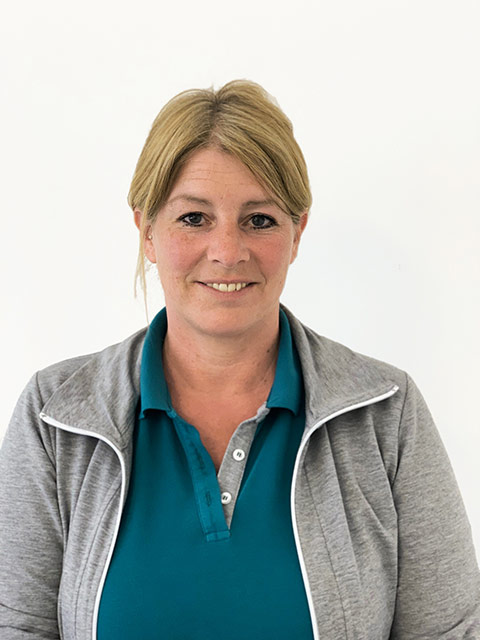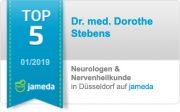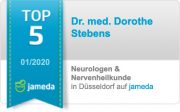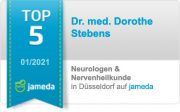
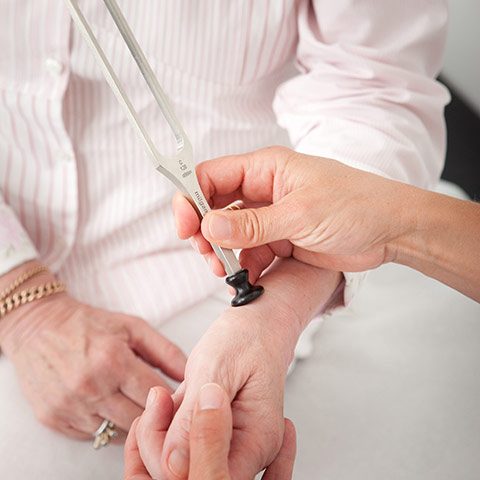
Range of treatment/diagnosis
Every successful therapy begins with a precise diagnosis
Our patients come to our private neurology practice with symptoms ranging from migraines to tinnitus to dementia – conditions that are as diverse as their possible causes. We take the time necessary to discuss your symptoms with you, arrive at the right findings and initiate the appropriate therapy. In our practice, diagnosis begins with dialogue.
The range of my activities as a neurologist encompasses all illnesses of the nervous system – brain, spinal cord and peripheral nerves – as well as ailments of the muscular system.
How can we help you? Speak with us about your symptoms.
Here you’ll find an overview of our range of treatment:
For example
– Migraines
– Tension headaches
– Cluster headaches
– Trigeminal neuralgia
For example
– Entrapment syndromes such as carpal tunnel syndrome, sulcus ulnaris syndrome
– Facial paresis
– Polyneuropathies, e.g. in the case of diabetes mellitus
– Neuroborreliosis
– Motor neurone diseases
– Root irritation syndromes in cases of degeneration of the spine and neuropathic pain syndromes
For example
– Prolapsed discs
– Root irritation syndromes in the case of degeneration of the spine
– Spinal stenosis
– Radiculopathy
– Whiplash
– Cervicogenic headaches
For example
– Parkinson’s syndrome
– Normal pressure hydrocephalus
– Gait disorders
– Tremor
– Dystonia
For example
– Strokes/cerebral haemorrhages
– Vascular malformations/constriction of brain-supplying vessels
– Cerebral microangiopathy
For example
– Alzheimer’s disease
– Dementia in case of circulatory disorders
– Dementia in case of Parkinson’s disease
For example
– Myasthenia gravis
– Myositis (muscle inflammation)
For example
– Restless legs syndrome
– Trouble falling asleep or sleeping through the night
– Narcolepsy
– Sleep apnoea syndrome
– Parasomnias (sleepwalking, REM sleep behaviour disorder)
For example
– Epilepsy
– Syncope/fainting spells
– Drop attack
– Tetany
– Brainstem seizures
For example
– Benign paroxysmal positional vertigo
– Ménière’s disease
– Peripheral vestibular vertigo
– Staggering vertigo
– Circulation disorders of the brain
– Cerebellar disorders
– Tinnitus
For example
– Retrobulbar neuritis
– Meningitis
– Encephalitis
– Myelitis
Examination methods
Neurology with advanced technology
A thorough physical neurological examination precedes every treatment. Our private neurology practice is equipped with up-to-date diagnostic technology. First and foremost, however, each patient is a person – with a specific medical history that plays a decisive role in our diagnostics. Knowledge of pre-existing conditions you may have and previous therapies you have undergone, as well as of your social environment, helps us to tailor any necessary medication or treatment to you individually. The following gives you an overview of our examination methods for making an accurate diagnosis.
Neurologists speak of the discharge and registration of fluctuations of potential in the electrical activity of the brain – in other words, the recording of brainwaves by means of electrodes applied to specific locations on the scalp. This technology is used in cases of epilepsy, but also in patients with headaches, dementia and sleeping disorders, and following strokes.
In order to answer certain medical questions, so-called activation methods are used. Neurologists employ procedures of this kind, like hyperventilation, to induce particular measurable reactions in the brain.
An EEG is safe and painless, and usually takes 20 to 30 minutes. Please bring a comb with you and avoid using hairspray before the procedure.
Electroneurography is utilised in a neurologist’s practice to measure a patient’s maximum motor and sensory nerve conduction velocity.
This involves stimulating motor or sensory nerves on the arms or legs with electric current. The method is used with nerve conditions such as pressure damage or polyneuropathy – that is, in maladies of the peripheral nervous system.
Because of the close medical relationship between the nerves and muscles in the body, it is sometimes necessary to measure the electrical activity of the musculature. This is exactly what happens in an EMG test. A thin needle electrode is inserted into the muscle and its activity is assessed in various functional states, such as at rest or in tension. Because muscle function depends on nerves and nerve roots, certain muscle and nerve illnesses can be diagnosed by this method.
This refers to the measurement of brainwaves that are induced by specific stimuli. It enables the neurologist to evaluate the conductivity and functioning of the neural pathways.
The stimuli can be applied acoustically via headphones (AEP), visually by means of a changing chequerboard pattern on a screen (VEP) or electrically directly to a nerve (SEP).
Evoked potentials are a diagnostic tool for many types of inflammatory, vascular or traumatic lesions, especially of the brainstem. Beyond this, dermatome SEPs evoked sensorily through electrical stimuli are used to diagnose root irritation syndromes in the case of spinal diseases.
This method is especially well suited to the early recognition of vascular changes which bring an increased risk of stroke. The blood vessels supplying the neck and brain are examined using duplex and Doppler sonography. These ultrasound procedures allow the representation of blood flow, possible constriction and arteriosclerotic calcium deposits in the arteries within and outside the brain.
Dementia can manifest in a wide variety of symptoms. In addition to the typical disturbances of memory, signs of dementia also often include disorientation, personality changes or depressive symptoms. The presence of dementia can often even be recognised in conversation and through the observation of behaviour. Memory disturbances, especially, can be determined early by means of neuropsychological testing. Further neuropsychological testing procedures enable the neurologist to differentiate between dementia and a depressive disorder (pseudodementia).
In order to identify the cause of a case of dementia, further examinations are necessary. In addition to a physical neurological examination, basic diagnostics include imaging procedures such as a skull CT scan or MRI, EEG and blood analysis. Depending on the suspected cause, additional specialised diagnostic procedures may follow, such as SPECT or the extraction of spinal fluid.
Certain questions require laboratory tests for the differential-diagnostic evaluation of neurological illnesses and in order to make an accurate diagnosis.
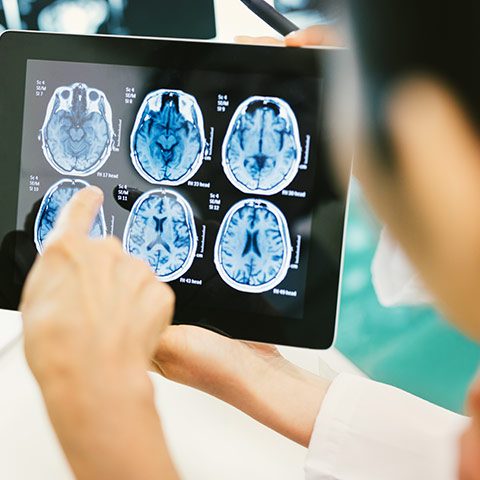
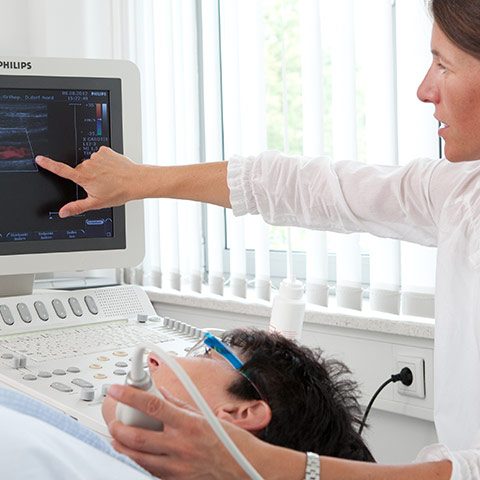

Dr. Dorothe Stebens
Making a difference through experience and scientific curiosity
‘When I assumed the helm of our private medical practice in Düsseldorf’s Einbrungen quarter in 2012, I had acquired over a decade of experience in the treatment of neurological illnesses – through my years of work in neurological intensive care units, in sleep laboratories and in geriatric psychiatry. This wide-ranging experience has proven invaluable not just to me, but also to my patients today. As a member of the Deutsche Gesellschaft für Neurologie, I’m in constant exchange with other neurologists and always up to date with the science in our field.’
1993-2000
Studies in human medicine at RWTH Aachen University, Aachen
2000-2006
Specialised training in neurology at the Kliniken Maria Hilf,
Mönchengladbach, under Prof. Dr J. Haan
2005
Doctorate
2007-2009
Specialised training in psychiatry
at St.-Alexius-/St.-Josef-Krankenhaus, Neuss, under Dr M. Köhne
2009
Specialist in neurology
2010-2012
Employment as licensed neurologist, Düsseldorf
02/2012
Private medical practice in Wittlaer, Düsseldorf
Stephanie Paliga
In good hands, right from the start
‘As a medical assistant, my area of responsibility encompasses the full range of activities, from making appointments and carrying out examinations to ordering prescriptions and preparing invoices. I know every patient well and can almost always help spontaneously and flexibly. In our practice, “personal” means just that: from one human being to another.’
Stephanie Paliga
